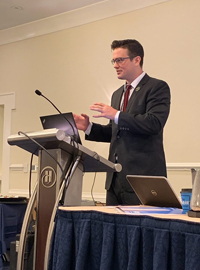2019 Funding Cycle Awardees
View other award years: 2024 • 2022 • 2021 • 2020 • 2019
Please note: Listing describes appointments and affiliations at the time of award. Please check our Trainees and Alumni pages for current appointments and affiliations.
- Title: “The effect of IQOS introduction on cigarette sales: the role of prices in product substitution”
- PI: Michal Stoklosa, Graduate Student at University of Cape Town
- Abstract and accomplishments +
- Abstract
- Introduction: In October 2018, Japan introduced a new HTP tax category and increased the excise rate on cigarettes. Aims: We examine the impact of the new tax and the corresponding price increase on the use of the two products. Methods: We use 2015 to 2019 monthly shop-scanner data from 11 of Japan’s 12 geographical regions (n=435). The method involves panel data analysis including through seemingly unrelated regressions (SUR). We estimate the own- and cross- price elasticity of demand for HTPs and cigarettes, which capture the products’ sensitivity to prices. We control for likely covariates, including income, a time trend, and the seasonality of sales. Results: Our results find that after the 2018 tax increase, the price increased across all HTP brands. The weight-based tax favored hybrid HTP technology. To cushion the users against the HTP tax, Japan Tobacco increased the HTP price by less than the tax increase while Philip Morris International introduced a less-expensive HTP brand. The estimated price elasticity for cigarettes and HTPs combined is -0.8. Cross-price effects are positive in all models, indicating that when the price of one product rises, use of the other product increases. Implications: Our findings affirm that HTP use is highly responsive to price increases, such as through taxation. Our findings also suggest that HTPs are more responsive to price changes than cigarettes, and that HTPs and cigarettes are substitutes. The study results can help to improve policy development in jurisdictions where HTP taxation is being considered.
 Michal StoklosaUniversity of Cape Town
Michal StoklosaUniversity of Cape Town- Title: “Game Theoretic Modelling of Tobacco Industry Responses to a Proposed Ban on the Sale of Menthol Flavored Cigarettes”
- PI: Dr. Michael Hayashi, Post-doctoral Research Fellow at University of Michigan
- Abstract and accomplishments +
- Abstract
- Introduction: At every step along the regulatory pathway, the FDA meets resistance when promulgating rules that the tobacco industry perceives as harmful to its interests. Moreover, the industry has responded to past regulation by adapting its business practices to ensure ongoing profitability. Therefore, it is critical for regulators and tobacco control researchers to understand how the tobacco industry might respond to new regulatory actions, particularly in the context of a potential ban on the sale of menthol cigarettes. We apply a systems modeling approach using game theory and population simulations to address this issue. Aims: Aim 1: Investigate optimal methods for the FDA to minimize smoking prevalence and health disparities by implementing a ban on the sale of menthol flavored cigarettes using game theoretic modeling to include and analyze the role of tobacco industry actors. • Sub-Aim 1.1: Construct a game theoretic model of menthol cigarette regulation to represent the strategic interactions between key actors including the FDA, cigarette companies, and consumers. • Sub-Aim 1.2: Analyze the model in 1.1 to determine the best policy options available to the FDA to implement menthol regulations that minimize the health burden and disparities of menthol cigarettes given the strategic responses of the tobacco industry. Results and Implications: Based on Nash equilibrium analysis of two game theoretic models developed for this project, we found that low costs relative to potential revenue losses for the tobacco industry as well as mixed stakeholder signals for the FDA likely prevented menthol regulations from progressing in 2013. We also found that differential market dominance between menthol cigarettes and e-cigarettes could incentivize a tobacco company dominant in e-cigarettes but not menthol to support menthol cigarette regulations if they believe enough consumers would switch to e-cigarettes following a ban. Together, these results suggest that modeling industry and other key regulatory actors could provide insight into conditions that would enable or inhibit successful tobacco regulations.
- Accomplishments
- We presented our work at the 2020 meeting of the Society for Research on Nicotine & Tobacco, as well as a November 2020 CAsToR webinar.
 Dr. Michael HayashiUniversity of Michigan
Dr. Michael HayashiUniversity of Michigan- Title: “Tobacco Product Marketing Regulatory Policies and Disparities Due to Minorities’ Diminished Returns”
- PI: Dr. Shervin Assari, Assistant Professor at Charles R Drew University of Medicine and Science
- Abstract and accomplishments +
- Abstract
- Introduction: Most of the past work in tobacco use disparities has traditionally focused on mediational models, suggesting that a third factor such as socioeconomic status (SES), stress, or place is why marginalization status is associated with a higher tobacco use burden. Built on our past empirical and review studies, we advanced our understanding of Minorities’ Diminished Returns (MDRs) as an explanation for disparities in tobacco use. According to MDRs, disparities are in part due to the “less than expected” effects of SES on tobacco use in marginalized populations. Aims: Our study had three aims: (1) To test whether SES's protective effects would be smaller for marginalized than non-marginalized people; (2) To test whether tobacco promotion (point-of-sale advertisement) mediates such MDRs; and (3) To test whether these effects differ for product type, gender/sex, and age. Methods: We conducted a secondary analysis of the following data: 1) National Health Interview Survey (NHIS), 2) the Health and Retirement Survey (HRS), 3) the Health Information National Trends Survey (HINTS), 4) the Population Assessment of Tobacco and Health Study, and 5) Adolescent Brain Cognitive Development (ABCD) study. SES was the independent variable, use of various tobacco products was the outcome, and marginalization status (race, ethnicity, immigration, and lesbian, gay, and bisexual [LGB] status) was the moderator. Regression was used for data analysis. Results: We found that these MDRs: 1) hold for various tobacco products such as cigarettes, e-cig, and hookah, 2) hold across SES indicators such as education, income, and employment, 3) hold for Black, Hispanic, Asian American, LGB, and immigrant people. 4) hold for youth, adults, and older adults, 5) hold across all studies tested, 6) hold for prevalence and incidence of tobacco use, 7) hold for first-hand and second-hand exposure, 8) hold for tobacco-induced chronic diseases such as asthma, COPD, and heart disease, 9) hold for some of the neurocognitive correlates of tobacco use such as attention, inhibitory control, reward sensitivity, fun-seeking, cognitive control, and emotion regulation, and 10) are mainly due to structural processes such as segregation. One example is higher than expected exposure to tobacco ads in high SES people of color. Implications: Disparities in tobacco use are not all due to SES gaps and diminished gains that follow high SES for marginalized populations, which draw our attention to tobacco use disparities across the full spectrum of SES. Addressing tobacco inequalities and disparities requires frameworks that acknowledge middle-class people of color's high risk of tobacco use.
- Accomplishments
- January 2020: Dr. Assari authored an article resulting from his pilot project work. The article, published in JAMA Network Open, is entitled “Association of Educational Attainment and Race/Ethnicity with Exposure to Tobacco Advertisement among US Young Adults.”
 Dr. Shervin AssariCharles R Drew University of Medicine and Science
Dr. Shervin AssariCharles R Drew University of Medicine and Science- Title: “Electronic Cigarettes: Projecting Behavioral and Clinical Outcomes”
- PI: Dr. Krishna Reddy, Assistant Professor at Massachusetts’ General Hospital
- Abstract and accomplishments +
- Abstract
- Introduction: The net public health impact of electronic cigarettes (e-cigs) will depend on the balance of three factors: 1) how much they help current smokers to stop smoking tobacco; 2) how much they promote adolescent and young adult non-smokers to develop nicotine dependence and transition to tobacco; and 3) how much e-cigs themselves confer health risks. Data are emerging about these factors, but long-term effects are unknown. Simulation modeling offers a valuable method of addressing policy-relevant questions that cannot be readily answered via conventional trials or observational cohorts. Methods: This proposal leveraged our new Simulation of Tobacco and Nicotine Outcomes and Policy (STOP) microsimulation model of tobacco- and nicotine-related behaviors and clinical outcomes. This project aimed to add structural and parameter detail to the STOP model to specifically examine e-cigs and their potential impact on tobacco smoking behaviors and health outcomes. The study performance included model design and implementation, model parameterization, and epidemiologic analysis. We designed, specified, programmed, and debugged new e-cig components of the STOP model. Meanwhile, we looked to data from the Population Assessment of Tobacco and Health (PATH) Study to begin to parameterize the model with behavioral transitions between various states of tobacco smoking and e-cig use. We also performed epidemiologic analysis using PATH data, specifically examining the association between e-cig use, tobacco smoking, dual use, and respiratory symptoms. Results: Our results include a new e-cig model structure and the development of preliminary multistate models of behavioral transitions. We have also found, from PATH data, that dual use of e-cigs and tobacco smoking is associated with significantly higher incidence of respiratory symptoms compared with use of either product alone. FUTURE DIRECTIONS: Next steps include further development of multistate models of behavioral transitions and model parameterization. We will use the model to project changes in health outcomes associated with various e-cig regulatory policies.
- Accomplishments
- JULY 15, 2021: Dr. Reddy was the lead author on a short original research article based on his pilot project research. The paper, entitled “Respiratory Symptom Incidence among People Using Electronic Cigarettes, Combustible Tobacco, or Both” was published in the American Journal of Respiratory and Critical Care Medicine.
- AUGUST 2021: Dr. Reddy received an Innovation Award (PDF) from the American Lung Association for the project, “The Public Health Impact of Electronic Cigarette Policies.” This grant will support research that began during Dr. Reddy's CAsToR pilot project period.
- APRIL 14, 2023: Dr. Reddy was co-author of an article based on his pilot project research. The paper, entitled “Longitudinal transitions in initiation, cessation, and relapse of cigarette smoking and e-cigarette use among US youth and adults: Validation of a microsimulation model” was published in PLOS ONE.
 Dr. Krishna ReddyMassachusetts’ General Hospital
Dr. Krishna ReddyMassachusetts’ General Hospital- Title: “Impact of new product standards for JUUL among dual JUUL/combusted cigarette users”
- PI: Dr. Lauren Pacek, Assistant Professor at Duke University School of Medicine
- Abstract and accomplishments +
- Abstract
- Introduction: Despite some data derived from hypothetical tasks, little experimental research exists to evaluate how potential tobacco regulations might impact the use of other tobacco products in addition to the targeted product. It is critical to anticipate how potential restrictions on the e-cigarette market may impact e-cigarette and other tobacco product — such as combusted cigarette — use. Aims: The present study aims to evaluate: 1) topography and product appeal; and 2) demand for JUUL e-cigarettes that vary in flavor (e.g., tobacco vs. preferred) as compared to participants’ usual brand combusted cigarette. Methods: Participants will undergo 2 experimental visits during which they will have access to 2 controlled puffing volume apparatuses (CPVAs). One CPVA will always be loaded with their usual brand cigarette and the other will be loaded with a JUUL pod; in one session, the pod will be their preferred flavor and in the other, the pod will be tobacco flavor. In each session, we will measure: 1) topography and product appeal; and 2) relative reinforcement (via a concurrent choice task) of the provided combusted cigarette/JUUL products. ANTICIPATED Results: We hypothesize that: 1) relative to preferred flavor JUUL or combusted cigarettes, participants will take smaller puffs of tobacco-flavored JUUL and will rate it as less appealing; and 2) limiting JUUL to tobacco flavor will increase expended effort for cigarettes as compared to when JUUL are available in a preferred flavor. Implications: This work will provide the FDA with actionable information regarding the impact of a product standard limiting JUUL to tobacco-only flavor on the appeal and use of combusted cigarettes. This work is highly responsive to FDA research priorities by evaluating how “changes in tobacco product characteristics (such as flavors…) impact on tobacco use behaviors including… dual/poly use, transition to non-flavored products…”
- Accomplishments
- September 22, 2021: This project was, unfortunately, not completed due to challenges related to the COVID-19 pandemic. However, it has served as a springboard for other potential research projects, including a recently submitted R01 application.
 Dr. Lauren PacekDuke University School of Medicine
Dr. Lauren PacekDuke University School of Medicine- Title: “Understanding how personal networks shape young adults’ e-cigarette outcome expectancies and perceptions of FDA anti-vaping messages”
- PI: Joshua Barker, Roy H. Park Doctoral Fellow at University of North Carolina – Chapel Hill
- Abstract and accomplishments +
- Abstract
- Introduction: American young adults are among the cohorts most at risk of using electronic cigarettes. Despite the prevalence of use, there have thus far been no dedicated national campaigns aimed at curbing young adult vaping. Aims: This grant funded a dissertation that sought to examine how the composition and structure of a young adult’s social network as well as their baseline beliefs about e-cigarettes were associated with both young adult susceptibility and vaping frequency as well as their reactions to anti-vaping advertisements. Methods: Data for this dissertation comes from over 2,000 young adults recruited from online survey panels. Egocentric network data, baseline usage, susceptibility, quit intentions and vaping outcome expectancies were collected before respondents viewed one of two anti-vaping advertisement conditions and answered perceived message effectiveness items. Finally, post-exposure quit intentions, susceptibility, and vaping risk beliefs were assessed. Results: Results indicate strong support for the associations between both the composition (attitudes, behaviors) and the structure (density, size) of young adults’ social networks with vaping outcome expectancies, usage, and perceptions of anti-vaping advertisements.
- Accomplishments
- December 2020: Theoretical and empirical implications for message testing and anti-vaping campaigns were published in the dissertation and will be leveraged into upcoming journal and conference submissions.
 Joshua BarkerUniversity of North Carolina – Chapel Hill
Joshua BarkerUniversity of North Carolina – Chapel Hill